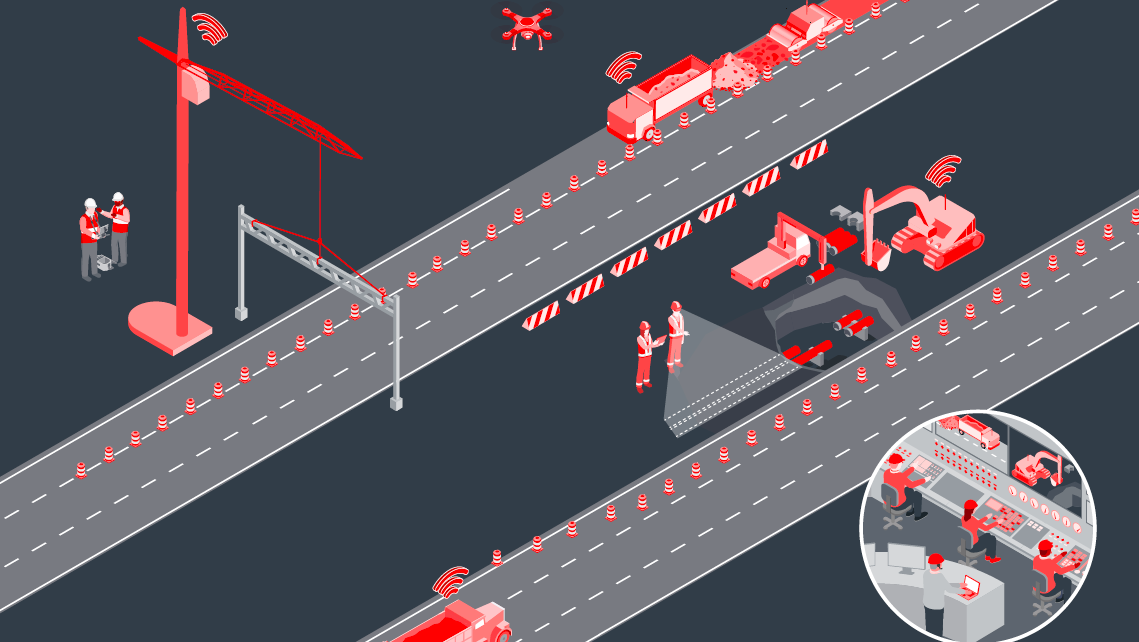
WSP has outlined its vision of the connected construction site.
The engineering consultant highlights 11 technologies that contribute to a connected construction site in a new report, Embracing Connected Sites in Construction.
The connected construction site starts with the use of a centralised command and control centre. This gives site supervisors, programme managers and delivery leads a single source of truth, providing continuous progress reporting.
Second is drone surveying, used to generate precise 3D models for initial designs, clash detection, and quality assurance. This forms the basis for a comprehensive digital twin for operations and maintenance, WSP said.
Third, intelligent compaction enhances consistent compaction quality, improving the performance of surface assets, extending their life and reducing the need for costly repairs.
Fourth is the establishment of a shared digital platform for tracking material logistics. This streamlines accurate bookkeeping, prevents the loss of goods received notes, and expedites the invoicing process within a scheme.
Fifth, excavators are equipped with semi-autonomous and autonomous technologies to deliver faster, more accurate excavation, cutting and grading by reducing the burden on operators and preventing costly reworks.
Sixth, workers use robotic load handlers to swiftly and efficiently perform manual handling tasks, reducing the risk to personal health and alleviating societal impact related to common musculoskeletal issues among construction workers.
Seventh, heavy machinery is remote-controlled, allowing skilled operators to remotely train junior colleagues and handle complex tasks with heavy machinery, especially in environments unsuitable for onsite personnel.
Eighth, the application of geofence and collision avoidance systems on construction machinery mitigate the risk of personnel operating too closely to heavy machinery by controlling equipment motion and issuing warnings to operators.
Revolutionising the process
Ninth, intelligent traffic management systems provide a continuous assessment of the quality of deployed traffic management to the command centre, eliminating drive-by surveys, while also warning onsite operatives of incursions or hazards.
Tenth, cranes are equipped with remote controls, 360-degree cameras, and local positioning systems to eliminate the need for people to work at height. This also enables crane operation in more confined spaces.
And finally, augmented reality headsets connect onsite and offsite workers, helping those on site to understand how designs interact with real construction locations. Guided workflows further enhance delivery speed and minimise errors.
Eric Peissel, global director, transport and infrastructure at WSP, said: “The vision of a connected site presents an opportunity to revolutionise the construction process toward enhancing productivity, project predictability, efficiency, and safety and supporting environmental sustainability.
Integrating digital solutions
“The core idea behind a connected site is to integrate cutting-edge digital solutions with intelligent infrastructure, creating a cohesive ecosystem where data-driven decisions and real-time collaboration are the norm.
“The connected site is an evolution of the growing use of digital twins, which capture continuously updated models of construction sites and assets across their lifecycle. The connected site builds upon this foundation of data and harnesses the power of autonomy, connectivity, advanced analytics, and augmented reality.
“Achieving the connected site vision will bring other benefits, including the elimination of silos, streamlined workflows, and optimised resource allocation. This vision reinforces the need for interoperability to link all aspects of the connected site, to implement a construction ecosystem that operates with unmatched precision, responsiveness, and foresight, while supporting safety and delivering productivity and efficiency improvements.”
Don’t miss out on BIM and digital construction news: sign up to receive the BIMplus newsletter.












